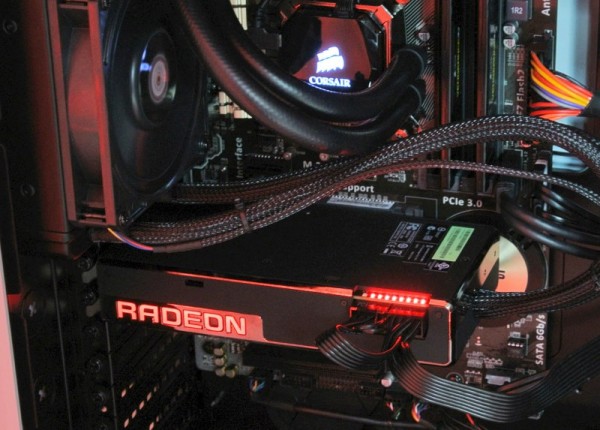
"We optimize our game performance so we don't see any limitation at all on 4K with 4 GB HBM. Compared to the Radeon R9 290X, the Radeon R9 Fury X covers just 3025mm2 on the PCB leaving the rest of the area to be better utilized by other technologies such as better electrical components, etc. That's a massive 9900mm2 surface area covered. A Radeon R9 290X has a PCB area, measuring 110x90mm covered by the chip and memory alone. The difference with HBM can be seen in the image below that shows a comparison between the Radeon R9 290X and the Radeon R9 Fury X. Each chip has a 1024-bit bus and the great thing about HBM is that it saves massive coverage area compared to GDDR5 chips which leads to interesting PCB designs such as the Radeon R9 Fury X, the Radeon R9 Fury X2 and the Radeon R9 Nano. These chips feature 1 Gbps memory speed and are capable to deliver up to 512 GB/s bandwidth. The HBM 1 chips which are 35mm2 in size are fused on the same package as the GPU die. AMD is the first graphics maker to have cards that utilize the new standard out in the market. High-Bandwidth Memory or HBM in short is the latest memory standard which will be replacing GDDR5 memory in graphics cards soon. The second great thing about the Fiji GPU is that cards based on the chip are also the first to incorporate the HBM memory standard. The chip may be big but the space it saves from HBM as you'll learn below transforms graphics cards into smaller and powerful designs.Ģ of 9 AMD HBM Standard - More Bandwidth, Power Efficient Designs, 94% Lesser Coverage Area The whole die measures a massive 1011mm2 while the interposer is designed with a 65nm process. The Fiji XT GPU alone deliver 1.5 times the performance per watt over Hawaii XT. Also comapred to Hawaii, AMD has managed to deliver several Micro architecture improvements along with enhanced power management features and a totally refocused look at board designs. Compared to Hawaii with its 6.3 billion transistors and 5.6 TFlops of performance, the Fiji GPU crunches out 8.6 TFlops of gpu performance from the depths of its heart. The chip which measures around 596mm2 has a total of 8.9 Billion transistors crammed under its hood which means a whole lot of performance and the card really does deliver a amazing amount of improvement in performance and efficiency over previous generation GPUs. The AMD Fiji GPU is based on a 28nm process and is the single largest chip AMD has ever produced.

Let's start off this post with an introduction to Fiji GPU. AMD Radeon R9 Fury X and Radeon R9 Fury X2 Fully Detailed AMD Fiji GPU - 28nm Process, 8.9 Billion Transistors, 8.6 TFlops of Compute The Radeon R9 Fury was called out at the event but never shown to the audience but we do know that it will feature an air cooler. Today, AMD officially unveils several details of their latest flagship graphics card, the Radeon R9 Fury X and we are going to detail every bit of this insane card. Two days ago, we got to see three impressive Fiji GPU based cards which include the Radeon R9 Fury X, Radeon R9 Fury X2 and the Radeon R9 Nano. AMD is done launching their latest Radeon graphics cards and the consumers have been most excited about the Fiji GPU based family.


 0 kommentar(er)
0 kommentar(er)
